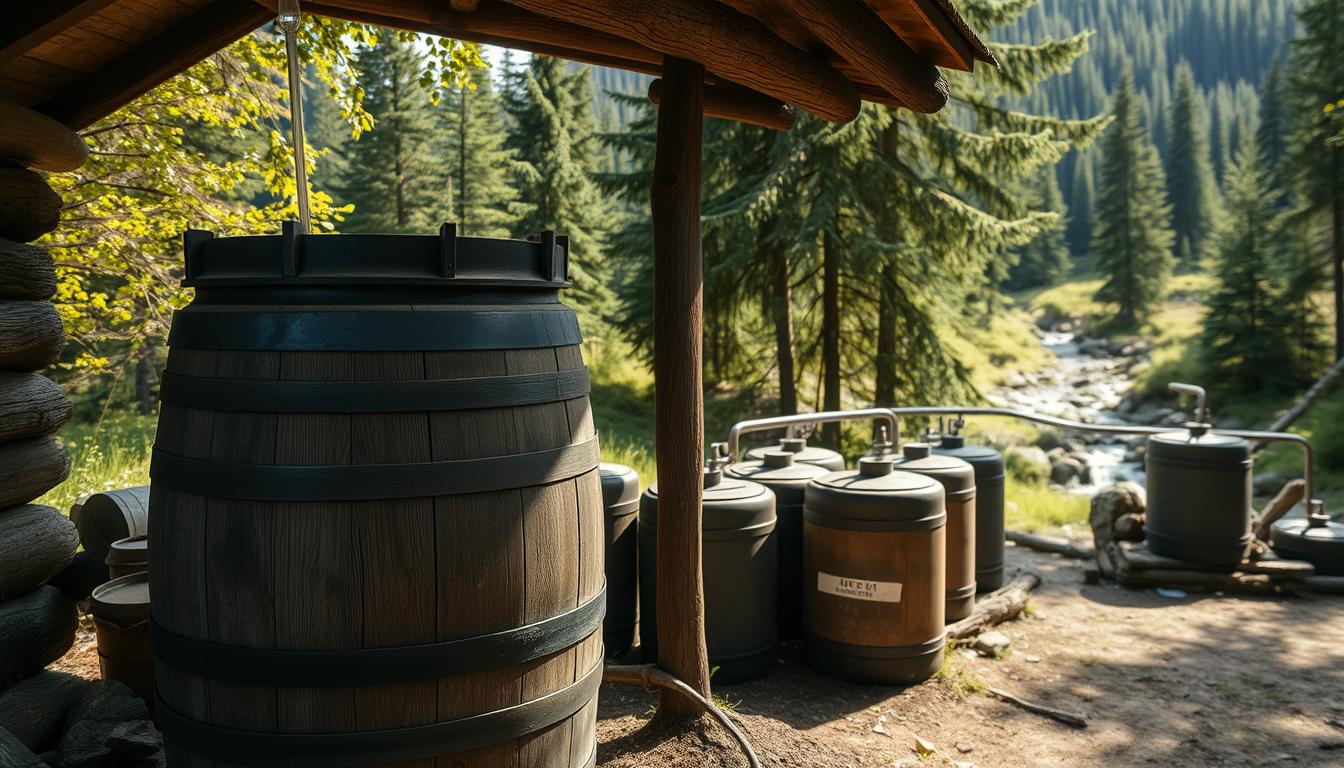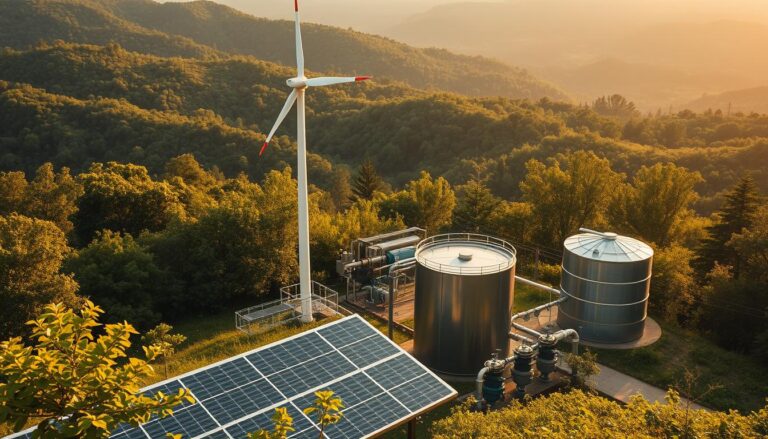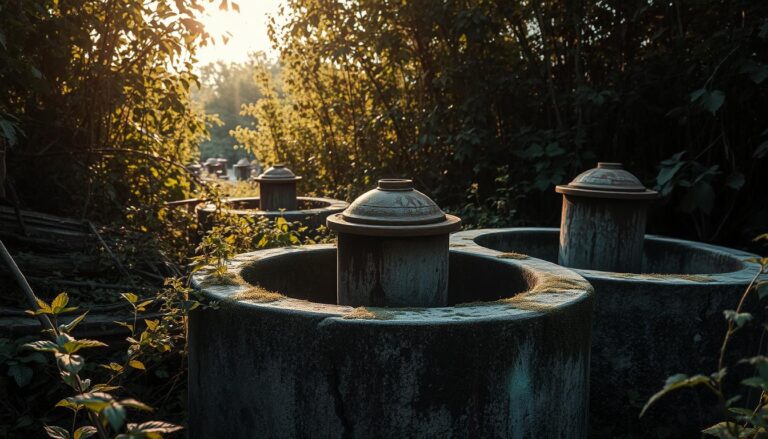Off Grid Water Storage: Tips for Storing Water
Securing a reliable water supply is crucial for off-grid living. But have you ever wondered if your water storage methods are truly effective?
Whether you’re building a homestead or just looking for a backup water solution, understanding the best practices for off-grid water storage is key to ensuring a steady supply of clean water.
A well-planned water storage system not only provides peace of mind but also self-sufficiency in times of need. In this guide, we’ll explore the essential tips for storing water effectively off the grid.
Key Takeaways
- Understand your water needs before choosing a storage solution.
- Select the right storage containers for your off-grid setup.
- Ensure your water storage system is clean and safe.
- Consider the location and maintenance of your storage system.
- Regularly inspect and maintain your water storage to prevent contamination.
The Importance of Water Storage in Off-Grid Living
Water storage plays a vital role in the sustainability of off-grid communities. It ensures a steady supply of water during emergencies and natural disasters, making it a critical component of off-grid living.
Why Water Security Matters
Water security is vital for off-grid living due to the potential for natural disasters and infrastructure failures that can disrupt water supplies. Having a reliable off grid water storage solution is essential for maintaining daily life and ensuring health and safety. Water security matters because it directly impacts the well-being and resilience of off-grid communities.
By storing water effectively, individuals can mitigate the risks associated with water scarcity and maintain their independence from municipal water supplies.
Common Challenges of Off-Grid Water Access
Common challenges of off-grid water access include maintaining water quality and dealing with seasonal variations in water availability. Water storage methods for off grid living must be designed to address these challenges, ensuring that water remains safe and accessible throughout the year.
Implementing effective water storage solutions can help overcome these challenges, providing a reliable source of clean water even in adverse conditions.
Understanding Your Water Needs
To set up a reliable off-grid water storage system, you first need to understand your water requirements. This involves assessing various factors that influence your daily water consumption.
Calculating Daily Water Requirements
Calculating your daily water needs is the first step in designing an effective off-grid water storage system. You need to consider drinking water, water for cooking, hygiene, and other household uses. A typical person requires at least 1 gallon of water per day for drinking, cooking, and hygiene.
Planning for Emergencies and Seasonal Changes
It’s crucial to plan for emergencies and seasonal changes that may affect your water supply. This includes assessing potential risks such as droughts, floods, or other natural disasters that could impact your water availability. Having contingency plans in place ensures that you have enough water stored for unexpected events.
Water Budgeting for Different Activities
Water budgeting involves allocating water for different activities such as drinking, cooking, cleaning, and gardening. By prioritizing your water needs, you can ensure that you have enough water for essential activities during times of scarcity.
Here’s a simple breakdown of water allocation for different activities:
| Activity | Daily Water Requirement (gallons) |
|---|---|
| Drinking | 1 |
| Cooking | 1-2 |
| Hygiene | 2-3 |
| Gardening (per 1,000 sq ft) | 20-40 |
How to Store Water Off Grid: Essential Methods
For those living off the grid, effective water storage is key to maintaining a reliable and clean water supply. The method you choose for storing water can significantly impact your daily life, from the simplicity of accessing water to the long-term sustainability of your off-grid system.
Short-Term vs. Long-Term Storage Solutions
When deciding on a water storage solution, one of the first considerations is whether you need a short-term or long-term storage system. Short-term storage solutions are ideal for emergency situations or temporary needs, typically holding enough water for a few days to a couple of weeks. On the other hand, long-term storage solutions are designed to sustain your water needs over extended periods, sometimes months or even years.
Above Ground vs. Underground Storage
The decision between above ground and underground water storage tanks depends on several factors, including available space, local regulations, and personal preference. Above ground tanks are generally easier to install and maintain, while underground tanks offer better protection against extreme temperatures and potential contamination.
Portable vs. Fixed Storage Systems
Another important consideration is whether a portable or fixed storage system is more suitable for your needs. Portable storage systems offer flexibility and can be relocated as needed, making them ideal for temporary or seasonal use. In contrast, fixed storage systems are more permanent solutions that can be integrated into your off-grid infrastructure.
Gravity-Fed Systems
Gravity-fed systems are a reliable and energy-efficient way to distribute water from your storage tanks. By leveraging gravity, these systems reduce the need for pumps, thereby minimizing energy consumption and simplifying system maintenance. They are particularly effective in terrains where there’s a natural slope or elevation that can be utilized.
- Gravity-fed systems reduce energy consumption.
- They simplify system maintenance by minimizing mechanical parts.
- Effective in terrains with natural elevation.
Water Storage Containers and Materials
Off-grid water storage solutions require careful consideration of the materials used for storing water. The right container can ensure water quality and longevity of the storage system.
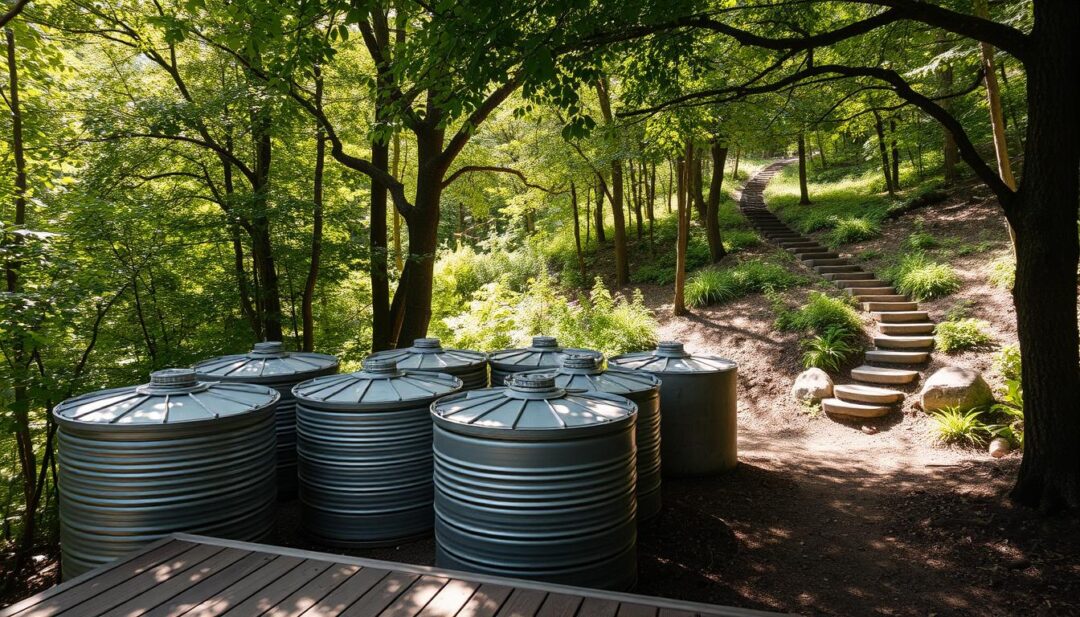
Plastic Tanks and Barrels
Plastic tanks and barrels are popular for off grid water storage solutions due to their lightweight and corrosion-resistant properties. They are easy to install and maintain.
Food-Grade vs. Non-Food-Grade Plastics
When choosing plastic tanks, it’s essential to differentiate between food-grade and non-food-grade plastics. Food-grade plastics are safe for storing drinking water, while non-food-grade plastics may leach chemicals into the water.
IBC Totes and Their Applications
Intermediate Bulk Containers (IBC) totes are another option for water storage. They are versatile, often used for storing and transporting liquids, and can be repurposed for rainwater harvesting systems.
Metal Cisterns and Tanks
Metal cisterns and tanks offer durability and can be used for both above-ground and underground storage. However, they require a protective coating to prevent rust and corrosion.
Concrete and Masonry Options
Concrete and masonry tanks are durable and can be built to last for decades. They can be constructed on-site and are suitable for large-scale water storage needs.
DIY Storage Solutions
For those looking for cost-effective options, DIY storage solutions can be a viable alternative. This can include repurposing old containers or building your own tank using local materials.
For more detailed information on setting up an off-grid water system, you can refer to a complete guide to off-grid water systems.
Off Grid Water Collection Techniques
Off-grid water collection techniques are vital for those seeking independence from municipal water supplies. Collecting water off-grid requires a combination of planning, technology, and maintenance to ensure a reliable and safe water supply.
Rainwater Harvesting Systems
Rainwater harvesting is a viable method for collecting water off-grid. It involves gutter systems and first flush diverters to maximize water quality.
Gutter Systems and First Flush Diverters
Gutter systems direct rainwater from rooftops into storage tanks, while first flush diverters allow the initial flow of water from the roof to be diverted, taking any debris and contaminants with it, and then allow clean water to flow into the tank.
Calculating Collection Potential
To determine the potential for rainwater collection, one must consider the roof catchment area, the average annual rainfall, and the efficiency of the collection system. A simple formula can be used to estimate the potential collection: Collection Potential = Roof Area x Rainfall x Efficiency.
| Collection Method | Advantages | Disadvantages |
|---|---|---|
| Rainwater Harvesting | Reliable source of clean water, reduces stormwater runoff | Dependent on rainfall, requires storage tanks |
| Well Water Collection | Can provide a consistent source of water | Requires drilling or digging, potential for contamination |
| Surface Water Collection | Can be a simple and cost-effective method | Potential for contamination, dependent on water source quality |
Well Water Collection
Well water collection is another method for obtaining water off-grid. It involves accessing groundwater through wells or boreholes.
Hand Pumps vs. Solar Pumps
The choice between hand pumps and solar pumps depends on the specific needs and resources available. Hand pumps are low-cost and simple but require manual effort, while solar pumps are more convenient but require an initial investment in equipment.
Surface Water Collection from Springs, Streams, and Lakes
Surface water collection involves drawing water from natural sources such as springs, streams, and lakes. This method requires careful consideration of water quality and potential contaminants.
Water Purification and Treatment Methods
Off-grid water purification is not just a necessity; it’s a lifeline for those living away from municipal water supplies. Ensuring the water collected is safe to drink is paramount, and various water purification and treatment methods are available for off-grid use.
Filtration Systems for Off-Grid Use
Filtration systems are a popular choice for off-grid water purification. They work by passing water through a filter to remove contaminants.
Ceramic, Carbon, and Membrane Filters
Ceramic filters are known for their effectiveness in removing bacteria and parasites. Carbon filters excel at improving taste and removing chlorine. Membrane filters, including reverse osmosis systems, can remove a wide range of contaminants, from dissolved solids to microorganisms.
Chemical Treatment Options
Chemical treatment involves adding disinfectants like chlorine or iodine to water to kill bacteria and viruses. While effective, it’s crucial to use these chemicals correctly to avoid health risks.
UV and Solar Purification
UV purification uses ultraviolet light to kill microorganisms, offering a chemical-free solution. Solar purification, or SODIS, involves exposing water to sunlight in clear bottles, leveraging UV rays to purify the water.
Boiling and Distillation
Boiling water is one of the simplest and most effective methods of purification, killing all types of bacteria and viruses. Distillation involves boiling water and then collecting the condensed steam, which is free from many contaminants.
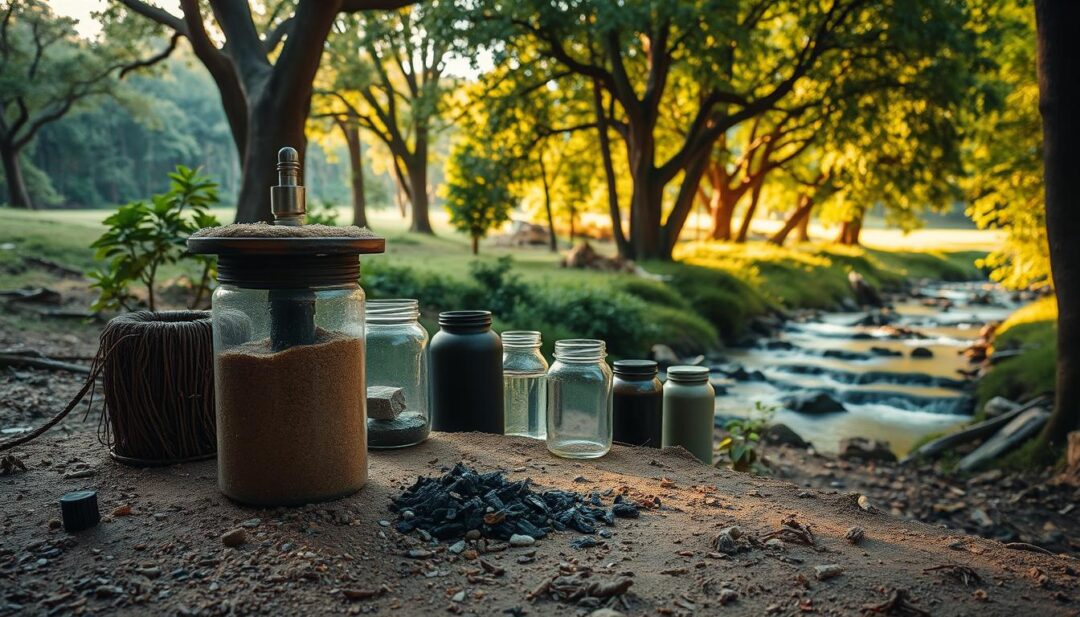
Maintaining Your Off Grid Water Storage System
To ensure a steady supply of clean water, maintaining your off-grid water storage system is essential. Regular maintenance not only prolongs the system’s lifespan but also ensures the water remains safe for consumption.
Regular Cleaning and Inspection
Regular cleaning and inspection are critical to prevent the buildup of sediment and contaminants. It’s recommended to inspect your storage tanks at least twice a year for signs of wear, damage, or contamination. Cleaning should be done gently to avoid damaging the tank’s interior.
During inspection, check for leaks, corrosion, and the condition of the tank’s lining. Ensure that all valves and fittings are secure and functioning properly.
Preventing Contamination and Algae Growth
Preventing contamination is key to maintaining water quality. This can be achieved by ensuring the tank is properly sealed and protected from external contaminants. Regularly checking the tank’s surroundings for potential sources of contamination is also crucial.
To prevent algae growth, consider using tanks with UV-resistant materials or applying a layer of shading to reduce sunlight exposure. Regularly testing the water for signs of algae or bacterial growth is also important.
Dealing with Freezing Temperatures
In colder climates, off-grid water storage systems must be protected from freezing temperatures. Insulating the tank or using freeze-proof materials can help prevent damage.
Consider installing a heating system or using a tank with a built-in heating element to keep the water from freezing. Regularly inspect the system during cold snaps to ensure it’s functioning correctly.
Troubleshooting Common Issues
Common issues with off-grid water storage systems include leaks, contamination, and equipment failure. Regular monitoring can help identify these issues early.
| Issue | Cause | Solution |
|---|---|---|
| Leaks | Damage or corrosion | Repair or replace damaged parts |
| Contamination | External contaminants | Seal the tank, clean, and disinfect |
| Equipment failure | Wear and tear | Regular maintenance and replacement of parts |
Cost Considerations and Budget Planning
Off-grid water storage solutions require careful budgeting to ensure long-term viability. The overall cost of such systems can be broken down into initial setup costs and long-term maintenance expenses.
Initial Setup Costs
The initial investment for an off-grid water storage system includes the cost of tanks, treatment systems, and distribution infrastructure. Tank costs vary widely depending on material and size, ranging from a few hundred to several thousand dollars. Treatment systems, such as filtration and UV purification units, add to the initial expense.
Long-Term Maintenance Expenses
Ongoing costs include regular maintenance, repairs, and potential upgrades to the system. Regular inspection and cleaning are crucial to prevent contamination and ensure water quality. Budgeting for these expenses is essential to avoid unexpected costs.
DIY vs. Professional Installation
Deciding between DIY installation and hiring professionals can significantly impact overall costs. While DIY can save on labor costs, professional installation ensures compliance with regulations and potentially reduces long-term maintenance costs. As one expert notes,
“A well-installed system can save you money and headaches in the long run.”
Conclusion: Building a Resilient Off-Grid Water System
Building a resilient off-grid water system requires careful planning and consideration of various factors, including water source, storage, treatment, and distribution. Understanding your water needs is crucial, with a family of four’s annual consumption ranging from 40,000 to 80,000 gallons. To achieve this, you can implement effective off grid water storage solutions.
For a four-member household, a reservoir capacity of 7,500 to 15,000 gallons is recommended. You can explore different storage options, including rainwater harvesting systems, which can yield roughly 550 gallons of water per inch of rainfall for every 1000 square feet of collection surface.
By following the guidelines outlined in this article, you can develop a comprehensive water system that meets your needs and withstands challenges. Effective off-grid water storage is key to how to store water off grid, ensuring a reliable supply for your household.

